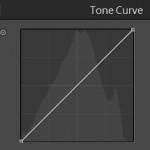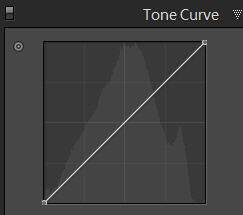 The tone curve is not the most intuitive feature of Lightroom or Photoshop. In this tutorial I will explain how to read the curve, and then how to use the basic version of it in Lightroom and Camera Raw. Note that this is a rewrite of an old post. If you are a Photoshop user, you will want to read the old one (but keep in mind that the Lightroom information is out-of-date there.).
The tone curve is not the most intuitive feature of Lightroom or Photoshop. In this tutorial I will explain how to read the curve, and then how to use the basic version of it in Lightroom and Camera Raw. Note that this is a rewrite of an old post. If you are a Photoshop user, you will want to read the old one (but keep in mind that the Lightroom information is out-of-date there.).
The tone curve is used to brighten or darken tones in your image. For general image brightening and darkening, I usually start with Exposure in the Basics panel to set how bright the brightest tones in the image should be, and then I move to the Brightness slider to set overall image brightness. Finally, I go to the Tone Curve when I want to affect just particular ranges of tones — for example, perhaps I want to brighten just the shadows or darken just the highlights in an image. In Lightroom, it is the panel directly below the Basics Panel in the Develop Module. In Camera Raw, it is the second symbol from the left below the histogram.
Reading the Tone Curve
Let me first say that if at the first mention of “graphs” and “X and Y axes”, your eyes are about to glaze over, you can skip down to “Using the Basic Curve”. You don’t have to know how to read the curve to use the basic version. However, consider giving it a try! If you fall asleep, I will take full responsibility — just please don’t read this while you are driving.
The curve starts out as a diagonal line in a graph (don’t worry if yours has different symbols around it):

Along the bottom (X) axis are all the possible tones, or brightness values, in your image, ranging from pure black (blocked up, in photography terms) at the left, through all the shades of gray in the middle, to pure white (blown out) at the right. (Regardless of what colors are in an image, I am speaking of brightness in terms of black/gray/white.) This X axis shows you the tones before you make any change. Along the vertical (Y) axis are the tones, again from pure black to pure white, AFTER your changes to the curve. The diagonal line/curve itself says what change you are making to your image. If you run imaginary lines straight from a tone on the Before (X) axis up to the Curve and then straight over to the left to the After (Y) axis, as I have done with some sample red dotted lines, you will see what that tone will be after applying the curve:

At this point I have not made any change at all, so the curve is a straight diagonal, and every point after is the same as it was before. There is no change to my image at this point.
Now I am going to bend the curve upward (how will be explained later):

Visually as I do this, I can see that it brightens my image. Drawing imaginary lines up from the Before (X) axis and over to the After (Y) axis shows me how much each tone is brightened. For example, medium gray is now light gray, and dark gray is now a little bit brighter. All tones are affected except pure black and pure white — they stay pure black and pure white. The midtones get the most brightening, and the change fades out over the lightest and darkest tones.
Now I will bend the curve downward, by a lot:
 Visually, this darkens my image a lot. Black and white are protected, but all other tones are affected. For example, light gray became medium gray, and dark(ish) gray became almost black.
Visually, this darkens my image a lot. Black and white are protected, but all other tones are affected. For example, light gray became medium gray, and dark(ish) gray became almost black.
In addition to brightening and darkening, you can add or subtract contrast with the Tone Curve. Adding contrast is a mix of brightening the bright tones of your image and darkening the dark tones, and makes the image look punchier. Here is a curve that does just that – it is called an S curve:
 You can also decrease contrast by bending down the bright tones and bending up the dark tones into a reverse S curve.
You can also decrease contrast by bending down the bright tones and bending up the dark tones into a reverse S curve.
So that is the explanation on how to read the curve. Let’s get to how you can make your own changes. There are two ways: using the basic (parametric) curve, and using the point curve. I will explain the former below, and the latter in a future post.
Using the Basic / Parametric Curve:
This is the version that you see when you first go to the Tone Curve panel. It has four sliders underneath it, and is particularly handy for those who don’t understand the curve itself. It’s also a convenience for all of us — I use it all the time. Highlights, Lights, Darks and Shadows by default each represent 25% of tones from black to white. Sliding any of the sliders in the Region section to the right brightens that range of tones, and to the left darkens that range. You will see the curve bend automatically as you slide the sliders:

You can also click on the Targeted Adjustment tool, circled in red above, and click-hold-and-drag up or down in your image. Lightroom will detect the tones underneath where you clicked, and adjust the appropriate slider. It simply saves you from having to figure out whether for example, the tones you want to affect are shadows or darks. When you are done using the tool, hit Escape to put it away (or it will follow you around!)
Sometimes the range you want to affect is narrower or broader than how these ranges are defined. For example, let’s say you want to darken the brightest highlights in your image, but when you slide the Highlights slider to the left, it doesn’t just affect the really-really bright ones that you want to affect — it is too broad in its definition of Highlights to achieve your goal. The triangles along the X axis at the base of the curve, in between shadows/darks/lights/highlights define how broad each range is. By default they are each 25%, but you can slide these triangles to redefine them. In my example, I would drag the one between highlights and lights to the right to define highlights as a narrower range, and then I would darken the range by sliding the Highlights slider in the Region section to the left:

Limitations to the Basic / Parametric Curve
Those of you that have made it this far in my post and paid close attention to my explanation of the sliders and ranges, will notice that I have not been quite truthful — you can see above that even though I defined highlights precisely as the brightest 15% of tones, that the curve does bend downward a little bit all the way down to middle gray. Here’s an even more obvious illustration, going back to when I had ranges defined as 25% each. I have just brightened the Lights, with the Lights slider. Notice how the darks and highlights are also somewhat affected:

This is done to protect you — that is, to maintain smooth transitions in tones. The change primarily affects the Lights, but gradually fades out over the Darks to the left, and the Highlights to the right. If it was instead abrupt, you could potentially wreak havoc with your image — you could see choppiness or banding. Sometimes, though, you want full control to define which tones are affected, rather than having to surrender to Lightroom’s guiding hand. For this you will need the Point Curve, which is the second available version of the curve in this panel. I will cover this in a future post.
Watch Videos on the Tone Curve and Much More:
See this in action, and learn about the point curve and color curves in my Lightroom 5: The Fundamentals & Beyond video series — 12 1/2 hours of training for beginning and experienced Lightroom users.
[sc:signup]